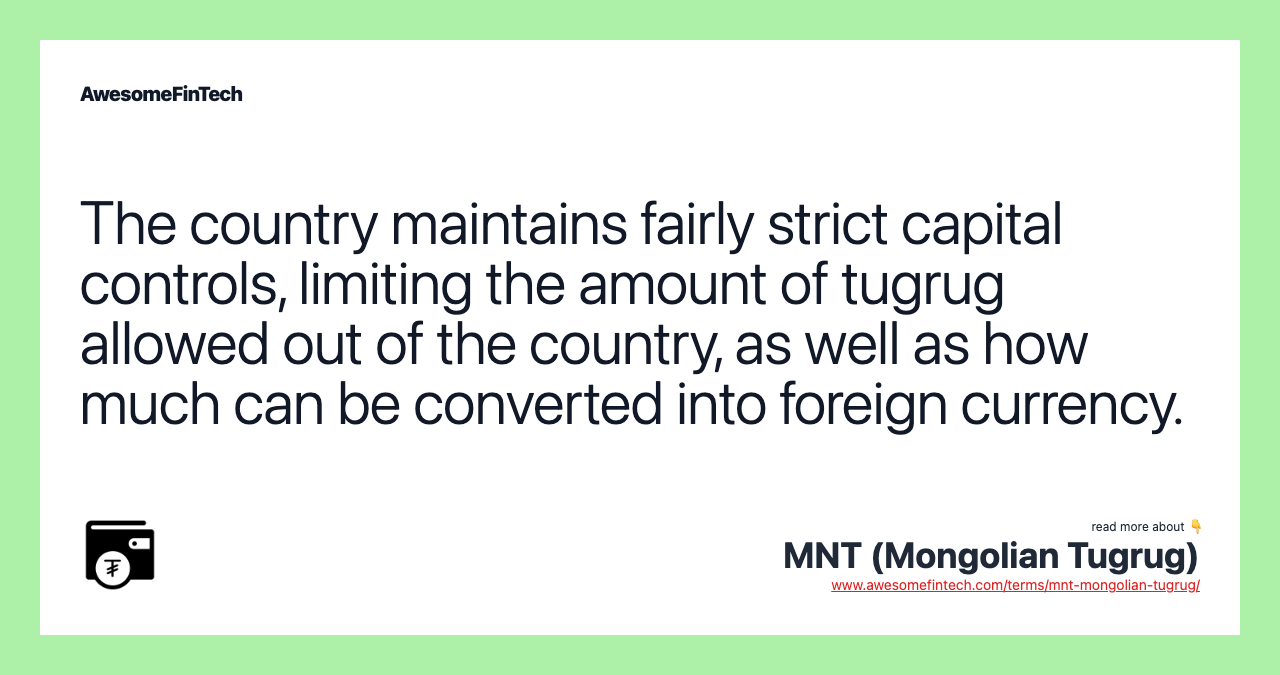MNT (Mongolian Tugrug)
MNT is the currency code for the _tugrug_, which also goes by tögrög or tugrik. The tugrug is the official currency for shares listed on the Mongolian Stock Exchange (MSE), which captured attention in the second half of the first decade of the 21st century for its exponential growth from 2006, when it was the smallest world stock market by capitalization to 2011 when it peaked. The Mongolian tugrug (MNT) is the official national currency of Mongolia since 1925. The Bank of Mongolia occasionally intervenes to maintain stable exchange rates with foreign currencies, but generally follows a floating exchange rate policy. Unless there is a superseding tax treaty, Mongolia applies a 20% withholding tax to all interest payments generated by foreign-held interest bearing dollar accounts.

What Is the MNT (Mongolian Tugrug)?
MNT is the currency code for the tugrug, which also goes by tögrög or tugrik. It is the official currency of Mongolia, using symbol is ₮, but sums are often written as “Tg” followed by the number, such as Tg 590. ₮1 can be subdivided into 100 möngö.
The Bank of Mongolia issues and manages the currency. As of September 2021, 1 U.S. dollar is equal to roughly 2,854 MNT.



Understanding the Mongolian Tugrug
MNT debuted in December of 1925, after a resolution from the Bank of Mongolia. The Bank of Mongolia occasionally intervenes to maintain stable exchange rates with foreign currencies, but generally follows a floating exchange rate policy.
The tugrug replaced the Mongolian dollar and began exchanging at par with the Soviet ruble. In 1928 the MNT became the only legal currency in the country. The tugurg is composed of 100 möngö, or one-hundredth of a tugrug, but after decades of high inflation, möngö are now too low in value for practical use as currency. Presently MNT banknotes range from 1₮ to 20,000₮ and coins from 20₮ to 500₮.
The tugrug has long been losing value in the foreign exchange market. In December 2011, $1 was worth approximately 1,350 tugrug. In December 2020, that same $1 was worth approximately 2,860 tugrug.
The tugrug is the official currency for shares listed on the Mongolian Stock Exchange (MSE), which captured attention in the second half of the first decade of the 21st century for its exponential growth from 2006, when it was the smallest world stock market by capitalization to 2011 when it peaked. Soon after, the MSE tumbled when foreign investment fell and China reduced its imports from Mongolia.
Mongolian Currency Restrictions
Inside Mongolia’s borders, all prices must be denominated in ₮ and paid in MNT. The Bank of Mongolia and the Financial Regulatory Commission have the authority to waive this restriction for specific transactions. Transactions that cross the Mongolian border are not bound by this rule and may be settled in foreign currency.
Travelers may prefer to exchange foreign cash at banks or hotels and withdraw from their accounts via ATMs, which offer competitive exchange rates. Mongolia is still largely a cash economy, and foreigners used to swiping their card for every transaction may need to get used to keeping cash on them.
Unless there is a superseding tax treaty, Mongolia applies a 20% withholding tax to all interest payments generated by foreign-held interest bearing dollar accounts.
Related terms:
Afghan Afghani (AFN)
The Afghan afghani (AFN) is the national currency of the Islamic Republic of Afghanistan. Prior to 2002, it was known as the AFA. read more
Automated Teller Machine (ATM)
An automated teller machine is an electronic banking outlet for completing basic transactions without the aid of a branch representative or teller. read more
ETB (Ethiopian Birr)
The Ethiopian birr (ETB), the national currency of the Federal Democratic Republic of Ethiopia, is issued by the National Bank of Ethiopia. read more
Floating Exchange Rate and History
A floating exchange rate is a regime where a nation's currency is set by the forex market through supply and demand. The currency rises or falls freely, and is not significantly manipulated by the nation's government. read more
Foreign Exchange (Forex)
The foreign exchange (Forex) is the conversion of one currency into another currency. read more
Par Value
Par value can refer to either the face value of a bond or the stock value stated in the corporate charter. read more
Polish Zloty (PLN)
The Polish zloty (PLN) is the national currency of Poland, issued by Narodowy Bank Polski. read more
Sudanese Pound (SDG)
The Sudanese pound (SDG) is the national currency of the Republic of Sudan. read more
Tax Treaty
A tax treaty is a bilateral agreement made by two countries to resolve issues involving double taxation of passive and active income. read more
Tugrik (MNT)
Tugrik (MNT) is the official currency of Mongolia and has been in use as the national currency since 1925. read more